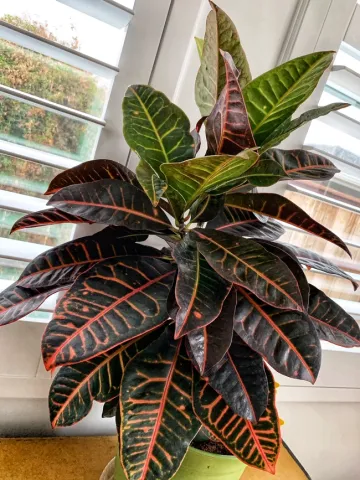
Croton
By Deborah Light-Pacheco UCCE Master Gardener
Common name of plant: Croton
Scientific name: Codiaeum, Variegatum “Pictum”
Planting area: Sunset zones, 24; H2; or Indoors
Size: Grown outdoors can reach 6 feet or taller, Indoors about 2-3 feet tall.
Bloom Season: Blooms insignificant
Exposure: Bright light, indirect sunlight, 6-8 hours a day
Pruning needs: As needed to maintain size
Water needs: Regular to ample water
Snapshot: This plant is native to Malaysia, the Pacific Islands and northern Australia. It is a woody based perennial that is typically grown for its glossy, leathery and brightly colored leaves which range from yellow, pink, orange, red, bronze, purple and green to any combination thereof. The leaves are also patterned with blotching and striping. This plant is better suited for use indoors on the Central Coast as it does not tolerate temperatures below 60 degrees Fahrenheit. They like a balmy 70-80 degrees Fahrenheit which can be achieved by placing your plant on pebble trays. Crotons love bright light, the more light, the more color variations and overall vigor. The moisture should be kept even and the soil should be one that drains well. Fertilize once a month. Crotons will drop their leaves if things aren't quite to their liking. They are fairly disease resistant, but may, on rare occasion, suffer from mealybugs, thrips, scale insects or spider mites. Crotons may be propagated by taking stem cuttings of 3 to 4 inches at the top of the plant. The cutting should have 3 to 5 healthy leaves. Then the cutting can be placed in a container of water until it roots. Change the water weekly and make sure the cuttings are in bright light. Once roots are about 2 inches, they can be repotted into soil. The cuttings may also be started in a moist soil by letting them grow normally. Note that the milky sap from this plant is toxic, so keep away from children and pets. It may also cause skin irritations.
Resources: Sunset Western Garden Book, houseplantcentral.com, gardeningchores.com
Have you thought about becoming a Master Gardener? Go to http://ucanr.edu/mgclassof2022 for information and an application.
We are still here!!!
No in-person workshops for now, but you can view workshops on:
Instagram live at slo_mg or visit our You Tube channel
at “San Luis Obispo County UC Master Gardeners”.
Visit our website; https://ucanr.edu/sites/mgslo/
or email us at anrmgslo@ucanr.edu
Our physical offices are closed, but you can still call or email questions:
San Luis Obispo 805-781-5939
Arroyo Grande 805-473-7190
Templeton 805-434-4105

